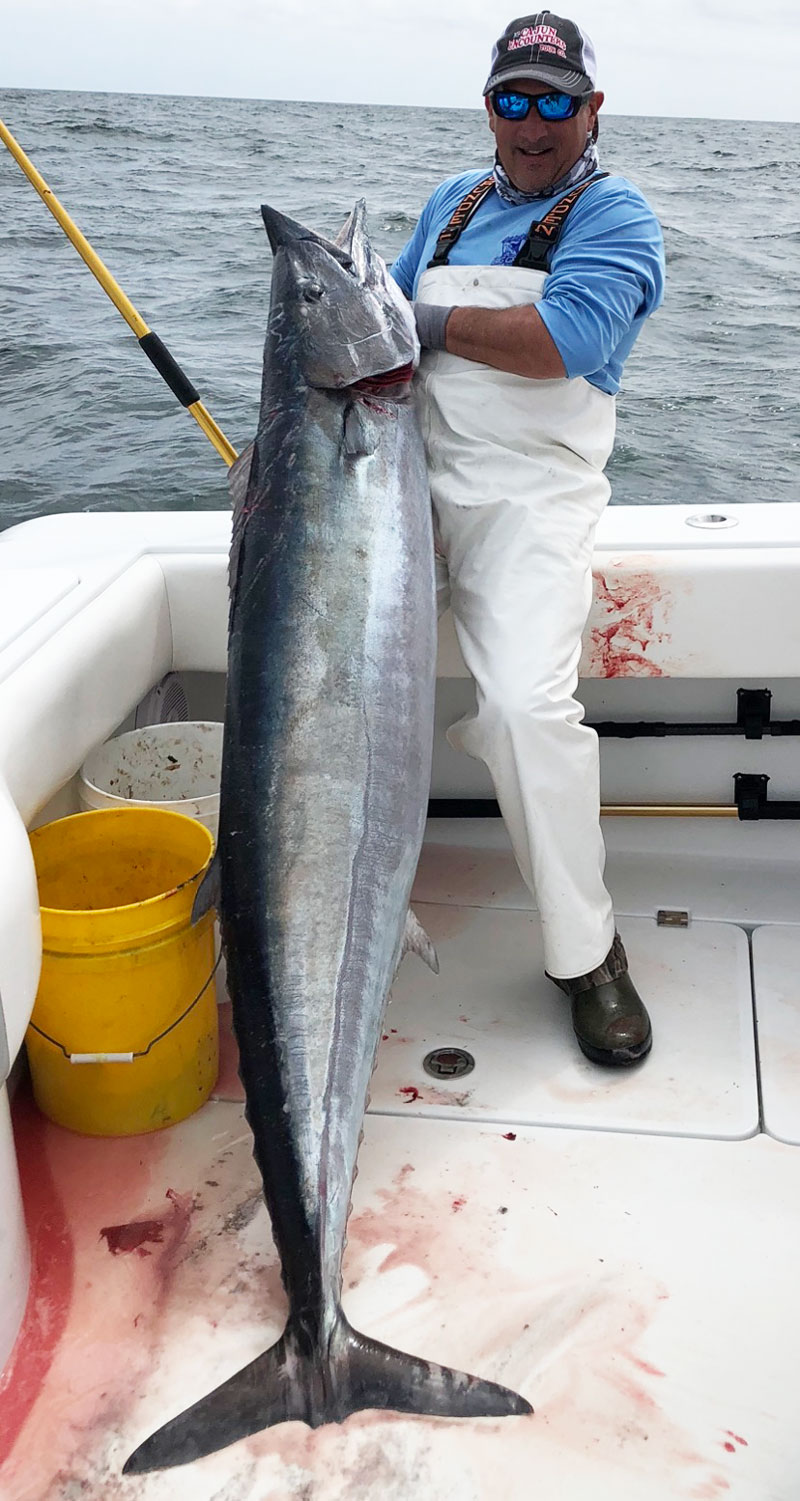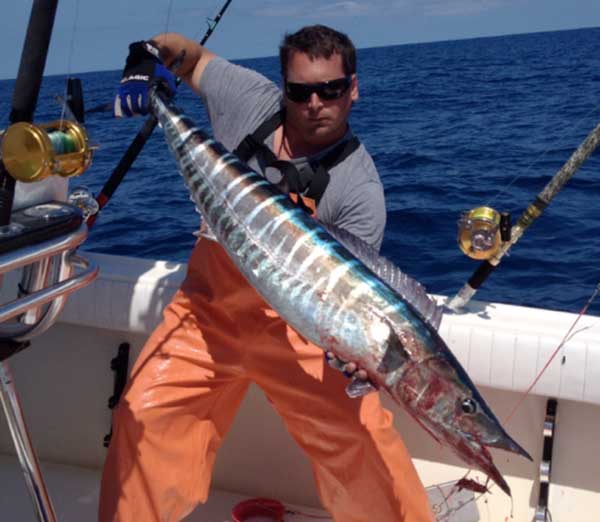The largest wahoo ever caught weighed 184 pounds. This record-breaking fish was caught in Cabo San Lucas, Mexico in 2005.
Wahoo, known for their speed and agility, are a prized catch for anglers worldwide. These fish are found in tropical and subtropical waters. The wahoo’s sleek, torpedo-shaped body allows them to swim at incredible speeds. Anglers seek them for their challenging fight and delicious meat.
The 184-pound wahoo caught in Cabo San Lucas set a world record, showcasing the potential size of these impressive fish. Catching such a large wahoo requires skill, patience, and the right equipment. Enthusiasts continue to be inspired by this remarkable achievement, hoping to match or surpass this legendary catch.
Introduction To Wahoo
The Wahoo is a fascinating fish species known for its impressive speed and size. Anglers worldwide seek to catch this remarkable fish. Understanding more about the Wahoo can enhance your fishing experience and appreciation for this species.
What Is Wahoo?
The Wahoo (Acanthocybium solandri) is a member of the mackerel family. It is renowned for its rapid swimming speed. These fish can reach speeds of up to 60 miles per hour. Wahoos have elongated bodies with vibrant blue and silver stripes. Their sharp teeth and streamlined bodies make them excellent hunters.
Habitat And Distribution
Wahoos are found in tropical and subtropical waters around the globe. They prefer deep, warm waters and are often located near the surface. These fish are abundant in the Atlantic, Indian, and Pacific Oceans. They are also found in the Caribbean Sea and the Mediterranean Sea.
| Region | Presence |
|---|---|
| Atlantic Ocean | High |
| Indian Ocean | Moderate |
| Pacific Ocean | High |
| Caribbean Sea | Moderate |
| Mediterranean Sea | Low |
Wahoos are migratory and follow the warm currents. They are solitary hunters but sometimes form small groups. They are often found near underwater structures like reefs and shipwrecks.

Credit: www.louisianasportsman.com
The Record-breaking Catch
The largest wahoo ever caught is a thrilling story. This catch amazed anglers around the world. This blog section will explore the details of this incredible achievement.
Details Of The Catch
On a sunny morning, the record-breaking wahoo was reeled in. The catch occurred off the coast of Cabo San Lucas. The wahoo weighed an astonishing 184 pounds.
The boat used was a 45-foot sportfisher. The angler used a 50-pound test line. The lure was a bright, flashy skirted bait. This combination proved to be perfect.
Angler’s Experience
The angler’s excitement was off the charts. He felt the fish tug fiercely. The fight lasted over an hour.
The angler’s hands were shaking. His heart was pounding. The crew cheered as the fish was brought aboard.
| Detail | Information |
|---|---|
| Weight | 184 pounds |
| Location | Cabo San Lucas |
| Boat | 45-foot sportfisher |
| Line | 50-pound test |
| Lure | Bright, flashy skirted bait |
These details make this catch legendary. It stands as a record to this day. Anglers everywhere dream of such a moment.
Record Measurement
The largest wahoo ever caught has set an astonishing new record. This amazing fish has stunned anglers worldwide. Let’s dive into the details of its record measurement.
Weight And Length
The weight of this incredible wahoo was a jaw-dropping 184 pounds. This makes it one of the heaviest wahoos ever caught. The length of the wahoo was equally impressive, measuring an astounding 7 feet 11 inches.
| Measurement | Value |
|---|---|
| Weight | 184 pounds |
| Length | 7 feet 11 inches |
Comparison With Previous Records
Comparing this catch with previous records shows its significance. The previous record-holding wahoo weighed 158 pounds. This new record surpasses it by 26 pounds.
- Previous Record Weight: 158 pounds
- New Record Weight: 184 pounds
- Weight Difference: 26 pounds
The length of the previous record wahoo was 7 feet 6 inches. The new record’s length exceeds it by 5 inches.
- Previous Record Length: 7 feet 6 inches
- New Record Length: 7 feet 11 inches
- Length Difference: 5 inches
This new record wahoo has set a high bar for future catches. Its remarkable size is a testament to the thrill of fishing.
Credit: www.360tuna.com
Fishing Techniques Used
Catching the largest Wahoo ever is an exciting adventure. The right techniques make all the difference. Fishermen use specific gear and bait to lure these big fish.
Gear And Equipment
Using the right gear and equipment is essential. Fishermen use strong rods and reels. These must withstand the Wahoo’s strength.
| Gear | Description |
|---|---|
| Rod | Heavy-duty and long for deep waters |
| Reel | High-speed with strong drag system |
| Line | Braided for strength and durability |
Fishermen often use braided lines. These lines do not break easily. Heavy-duty rods help in deep waters. High-speed reels help bring in the Wahoo quickly.
Bait And Lures
Bait and lures play a big role in catching Wahoo. Fishermen use live bait or artificial lures. Each has its advantages.
- Live Bait: Mimics natural prey
- Artificial Lures: Bright colors attract Wahoo
Live bait like mackerel works well. It mimics the Wahoo’s natural prey. Artificial lures with bright colors catch the fish’s eye. Fishermen often use trolling techniques. They drag the bait behind the boat. This method is effective in attracting Wahoo.
Challenges Faced
Catching the largest wahoo ever recorded was no small feat. Anglers faced numerous challenges during this historic catch. The following sections highlight the key obstacles they encountered.
Weather Conditions
Weather conditions play a crucial role in deep-sea fishing. On the day of the record catch, the sea was rough. High waves and strong winds made the situation even more challenging. The team had to stay focused to keep the boat stable. They also needed to navigate through turbulent waters.
Here’s a summary of the weather challenges faced:
| Challenge | Impact |
|---|---|
| High Waves | Made it hard to spot the fish. |
| Strong Winds | Difficult to keep the boat in position. |
| Stormy Weather | Increased risk of accidents. |
Fight With The Fish
The fight with the wahoo was intense and demanding. Wahoos are known for their speed and strength. This one was particularly aggressive. The angler had to use all his skills and experience. He fought the fish for over an hour. The wahoo tried to escape multiple times.
Key moments during the fight included:
- The initial strike of the fish.
- Long runs and sudden changes in direction.
- Maintaining tension on the fishing line.
- Carefully reeling the fish in without breaking the line.
The team had to work together to land the fish. They used special gear to handle the wahoo’s strength. This catch was a testament to their skill and teamwork.
Significance Of The Catch
The largest wahoo ever caught has amazed the angling world. This remarkable catch has important implications and brings excitement to the fishing community.
Impact On Angling Community
The catch has created a buzz among anglers globally. It has set a new benchmark for fishing enthusiasts. Many anglers now aim to break this record.
This event has also increased interest in fishing tournaments. More participants are eager to join and test their skills. Fishing gear sales have surged due to this renewed interest.
Here are some ways the catch has influenced the community:
- Increased participation in fishing events
- Higher demand for advanced fishing gear
- More discussions and forums on fishing techniques
Scientific Interest
Scientists are keen to study this largest wahoo. They are interested in its size, diet, and habitat. This catch provides valuable data for marine biology.
Researchers are conducting detailed analysis. They aim to understand the factors that contributed to its large size. This can help in conservation efforts.
Key areas of scientific interest include:
- Growth patterns of large wahoos
- Impact of environmental factors on size
- Genetic traits of the largest wahoo
| Scientific Area | Focus |
|---|---|
| Growth Patterns | Studying how wahoos grow to large sizes |
| Environmental Impact | Examining how the environment affects wahoo size |
| Genetic Traits | Identifying genetic markers for large size |
Wahoo Fishing Tips
Wahoo fishing is thrilling and rewarding. Catching the largest Wahoo requires skill and knowledge. Below are essential tips to help you succeed in your Wahoo fishing adventures.
Best Locations
Wahoo are found in tropical and subtropical waters. Key locations include:
- Bahamas: Abundant Wahoo can be found near reefs and drop-offs.
- Gulf of Mexico: Known for its rich fishing grounds.
- Hawaii: Ideal for both novice and experienced fishermen.
- Florida Keys: A popular spot for large Wahoo.
- Caribbean: Offers a wide range of fishing opportunities.
Optimal Seasons
The best seasons for Wahoo fishing vary by location. Generally, Wahoo are more active during specific times of the year:
| Location | Best Seasons |
|---|---|
| Bahamas | November to March |
| Gulf of Mexico | April to August |
| Hawaii | June to October |
| Florida Keys | December to February |
| Caribbean | Year-round, with peaks from May to September |
Conservation Efforts
The largest wahoo ever caught is a significant achievement. It also raises awareness about the importance of conservation efforts. Sustainable fishing practices and protection of marine life are crucial for the future. Let’s delve into the steps taken to ensure a balanced marine ecosystem.
Sustainable Practices
Sustainable practices are essential in maintaining marine biodiversity. Fishermen use regulated gear to minimize bycatch. This helps protect other marine species. Catch limits are set to avoid overfishing. These limits ensure wahoo populations remain stable.
Governments enforce seasonal restrictions. These restrictions allow wahoo to breed and grow. Marine reserves are established to provide safe havens for fish. These protected areas help maintain a healthy ecosystem.
Protecting Marine Life
Protecting marine life goes beyond sustainable practices. It involves educating communities about the importance of marine conservation. Schools and organizations conduct awareness programs. These programs highlight the importance of preserving marine habitats.
Regulations are in place to prevent marine pollution. Reducing plastic waste in oceans is a key focus. Coastal clean-up drives are organized to keep beaches clean. These efforts contribute to a healthier marine environment.
Collaboration with international bodies ensures global marine conservation. Joint efforts lead to better protection for migratory species. This includes wahoo and other important fish species.
| Conservation Effort | Description |
|---|---|
| Sustainable Practices | Regulated gear, catch limits, seasonal restrictions, marine reserves |
| Protecting Marine Life | Education, pollution prevention, clean-up drives, international collaboration |

Credit: www.saltwatersportsman.com
Frequently Asked Questions
What Is The Largest Wahoo Ever Caught?
The largest wahoo ever caught weighed 184 pounds. It was caught off the coast of Cabo San Lucas, Mexico, in 2005.
Where Was The Largest Wahoo Caught?
The largest wahoo was caught off the coast of Cabo San Lucas, Mexico. This location is renowned for its excellent fishing opportunities.
How Big Do Wahoo Fish Typically Get?
Wahoo fish typically weigh between 40 to 100 pounds. However, they can grow larger, with exceptional cases reaching up to 184 pounds.
What Is The Best Time To Catch Wahoo?
The best time to catch wahoo is during the warmer months. They are more active from late spring to early fall.
Conclusion
Catching the largest Wahoo ever recorded is an incredible achievement. This event showcases the thrill of sport fishing. Anglers worldwide are inspired by such feats. Each catch tells a unique story and fuels passion. Stay tuned for more fishing adventures and record-breaking tales.
Happy fishing!
